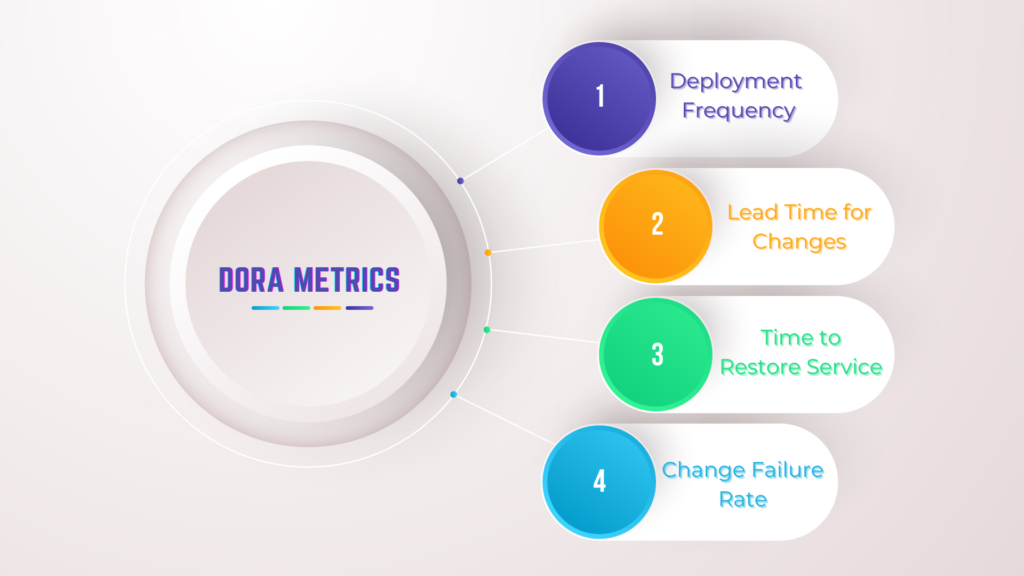Understanding DORA Metrics – Key Insights for DevOps Success 2024

Introduction to DORA Metrics
DORA metrics serve as vital indicators that DevOps teams use to enhance their software delivery processes. These metrics provide deep insights into the efficiency and effectiveness of development and operational activities. By measuring specific key performance indicators (KPIs), teams can uncover areas for improvement, ensuring faster and more reliable software delivery. The main DORA metrics include deployment frequency, lead time for changes, mean time to recovery (MTTR), and change failure rate. Each of these metrics plays a critical role in evaluating team performance and fostering a culture of continuous improvement.
What Are DORA Metrics?
DORA metrics are a set of key performance indicators developed by the DevOps Research and Assessment (DORA) team. They help organizations assess their software delivery and operational performance. The metrics provide a framework to evaluate how well a team is executing its development and operational practices. DORA metrics focus on aspects such as the speed of delivery and the reliability of the software. By using these metrics, teams can identify bottlenecks in their processes and implement changes that lead to more efficient workflows.
What Are DORA Metrics in Scrum?
In Scrum, DORA metrics play a significant role in evaluating the success of iterative development processes. These metrics allow Scrum teams to gauge their efficiency in delivering features and updates. Key DORA metrics, such as deployment frequency and lead time for changes, provide insights into how quickly teams can deliver functional increments. Additionally, mean time to recovery (MTTR) reveals how effectively teams can respond to incidents or failures. By incorporating DORA metrics into their Scrum practices, teams can enhance their performance and foster a culture of continuous improvement.
What Does DORA Stand For?
DORA stands for DevOps Research and Assessment. This organization focuses on researching and promoting best practices in software development and IT operations. DORA’s mission includes identifying the practices that lead to successful DevOps transformations. The DORA team has published numerous reports highlighting the importance of certain metrics in driving performance improvements. By leveraging DORA’s insights, organizations can better understand their capabilities and the areas that require enhancement.
What Is the DORA Framework?
The DORA framework encompasses a set of principles and practices designed to enhance software delivery performance. This framework emphasizes the importance of using data to drive decision-making and improvement efforts. Organizations can apply the DORA framework to assess their software delivery processes and operational performance through its key metrics. By doing so, teams can identify strengths and weaknesses within their workflows, allowing them to focus on specific areas that will yield the most significant impact.
What Is a DORA Assessment?
A DORA assessment is a process that organizations use to evaluate their current software delivery performance against the DORA metrics. During the assessment, teams analyze their deployment frequency, lead time for changes, MTTR, and change failure rate. This analysis helps organizations understand their strengths and identify areas for improvement. The DORA assessment provides actionable insights that teams can implement to streamline their processes and enhance overall performance.
The Importance of DORA Metrics
DORA metrics are essential for understanding software delivery performance. By monitoring these metrics, organizations can gain valuable insights into their development processes and operational efficiency. Regularly tracking DORA metrics enables teams to identify bottlenecks and areas that require improvement. This data-driven approach fosters a culture of continuous improvement, allowing teams to enhance their performance and deliver high-quality software more efficiently.
Key DORA Metrics Explained
- Deployment Frequency: This metric measures how often new releases are deployed to production. A higher deployment frequency indicates a team’s ability to deliver new features and fixes rapidly. Frequent deployments lead to quicker feedback from users, allowing teams to iterate faster.
- Lead Time for Changes: This metric tracks the time it takes for a code change to go from development to production. A shorter lead time indicates that the team can deliver changes quickly. Reducing lead time allows organizations to respond faster to market demands and user feedback.
- Mean Time to Recovery (MTTR): MTTR measures the average time it takes to recover from a failure in production. A lower MTTR indicates that teams can quickly address issues and minimize downtime. Reducing recovery time is crucial for maintaining user trust and satisfaction.
- Change Failure Rate: This metric indicates the percentage of changes that result in failures or incidents. A lower change failure rate suggests that teams are delivering high-quality code and that their testing and deployment processes are effective. Identifying and addressing issues related to change failures can lead to significant improvements in software quality.
Conclusion: Leveraging DORA Metrics for Success
Incorporating DORA metrics into your DevOps practices can lead to significant improvements in software delivery and operational performance. By focusing on these key performance indicators, teams can identify bottlenecks, improve their processes, and foster a culture of continuous improvement. DORA metrics provide organizations with the insights needed to navigate the complexities of software development effectively. Embracing this data-driven approach enables teams to deliver high-quality software faster and more reliably, ultimately enhancing customer satisfaction and business success.













